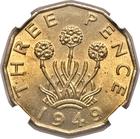Threepence, Brass, Thrift Plant, Coin Type from United Kingdom - detailed information
| ||||
The pre-decimal threepence (3d), usually simply known as a threepence or threepenny bit, was a unit of currency equalling one eightieth of a pound sterling, or three pence sterling. It was used in the United Kingdom, and earlier in Great Britain and England. Maundy Threepence have been issued for centuries (they are still being struck today for ceremonial purposes), and initially the circulating threepence were identical in design. Starting in 1927, they were made different - first with a design featuring three oak sprigs then one with a Tudor Rose, while the Maundy threepence continued with the traditional crowned numeral reverse. By the end of King George V's reign the threepence had become unpopular in England because of its small size, but it remained popular in Scotland. It was consequently decided to introduce a more substantial threepenny coin which would have a more convenient weight/value ratio than the silver coinage. The King Edward VIII reign saw the planned introduction of a new, larger, nickel-brass twelve-sided threepence coin. This coin weighed 6.6 grams and the diameter was 21 mm across the sides and 22 mm across the corners. A total of just 12 of these pattern coins were struck for experimental purposes and sent to a slot machine manufacturing company for testing, but no coins for Edward VIII were released. During the reign of King George VI, the new nickel-brass threepence format took over the bulk of the production of the denomination, being produced in all years between 1937 and 1952 except 1947. Apart from the king's head and name, and the weight being increased to 6.8 grams, the coin was identical to that prepared for Edward VIII. The silver threepence continued to be minted in parallel until 1945, as there may have been some uncertainty about how well the new coin would be accepted. At first the coins had sharp corners, but during 1941 a more rounded collar was used, as failure of the collars was occurring too frequently. In 1948, and from 1950, sharp edged collars were used again. Both types are known for 1949. The composition is 79% copper, 20% zinc, 1% nickel. A new reverse type, featuring a portcullis, replaced this design for the reign of Queen Elizabeth II. The coins remained in circulation until "Decimal Day", 15 February 1971, and ceased to be legal tender after 31 August 1971. Unlike some of the larger denominations, they were not re-denominated to a decimal value when the decimal Pound Sterling was introduced. | ||||
| ||||
| ||||
| ||||
| ||||
| ||||
 |
| Buy Austrian Silver Philharmonics Online |
 |
| Royal Mint |
| Country | United Kingdom |
|---|---|
| Currency | Pound Sterling (pre-decimal) |
| Sub-type of | Threepence, Circulating |
| From | 1937 |
| To | 1952 |
| Face Value | 3 (x Penny) |
| Current | No (demonetised 1971) |
| Material | Nickel Brass (Neusilber) |
| Designer | Francis Madge Kitchener |
| Technology | Milled (machine-made) |
| Shape | Dodecagonal (12-sided) |
| Orientation | Medal Alignment (Axis 0) |
| Size | 21.8000 mm |
| Thickness | 2.6000 mm |
| Mass | 6.8000 g |
 |
| Buy Silver Bullion Online |
| Image | Details |
|---|---|

|
Great Britain 1949 3 pence
Copyright: CoinFactsWiki / CC BY-SA Author: Heritage Auction Galleries Notes: Common reverse (1937 - 1952). Source |

|
1943 Brass Threepence
Copyright: JNCoins Notes: King George VI, Emperor of India (1937 - 1948). Source |

|
Great Britain 1949 3 pence
Copyright: CoinFactsWiki / CC BY-SA Author: Heritage Auction Galleries Notes: King George VI (1949 - 1952). Source |

